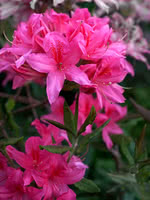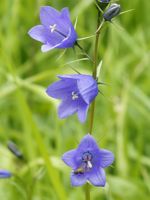Mon-Fri 9am - 5pm Mountain time
Rosy Lights Rhododendron (Azalea) vs Harebell
Rhododendron x Rosy Lights
Campanula rotundifolia
CUSTOM GROW
NOT AVAILABLE THIS SEASON - MIGHT RETURN
Rosy Lights Rhododendron is the next flowering, deciduous shrub you need in your garden. It is incredibly cold hardy and produces fragrant, bright pink blooms in late spring. Pruning is recommended after the flowers are finished to control the size and shape of this shrub.
Try Rosy Lights Rhododendron when planning your next hedge/screen, or plant it on its own as a striking accent plant. Part of the Northern Lights Series.
Harebell is a native perennial wildflower known for its bell-shaped, blue-violet flowers. The noddling blooms occur in clusters at the top of slender stems. Blooming in bursts from summer to fall, the flowers attract pollinators such as butterflies, bees, and hummingbirds.
Regular deadheading encourages additional blooms, extending its floral display through the season. Harebell prefers areas with cooler summer climates and does poorly in those that get too hot and humid. It is well suited for native wildflower gardens, pollinator gardens, and naturalization projects.
Rosy Lights Rhododendron (Azalea) Quick Facts
Harebell Quick Facts
Toxicity: All parts of a rhododendron bush, including the leaves, stems and blooms, are toxic to cats, dogs, and horses.

